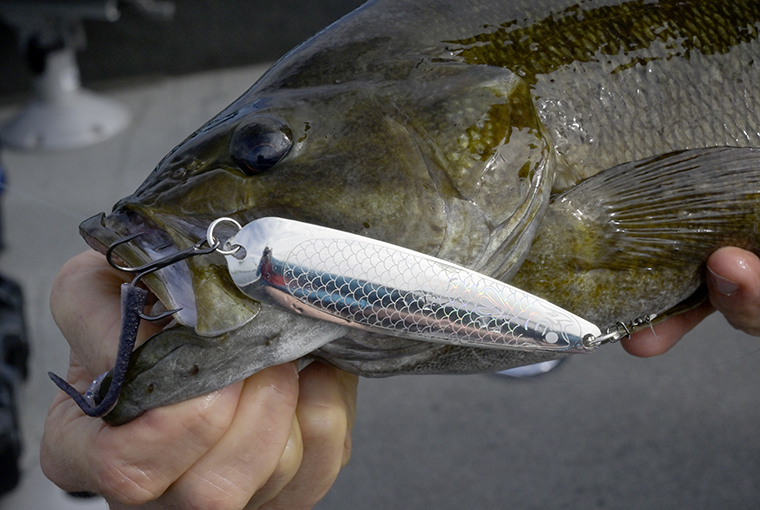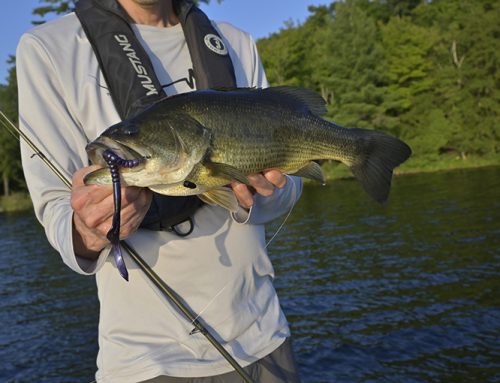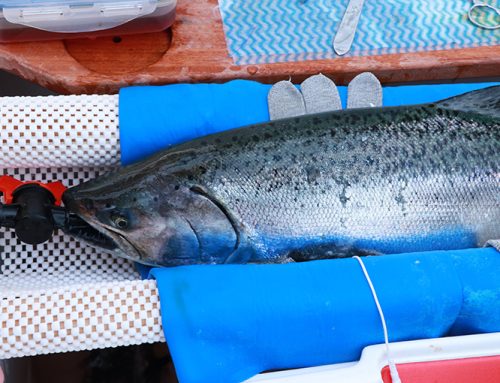
Jigging spoons can be irresistible for smallmouth feeding on baitfish at any time of the year. In my experience, casting and jigging spoons can catch smallmouth when trending techniques prove unsuccessful in summer as much as autumn.
Here’s what you need to know.
Why spoon in summer?
Watch a spoon flutter, wobble, and flash in the water and it’s not hard to imagine how a smallmouth would see it as an alewife, smelt, shad, or minnow. Another reason to consider fishing spoons more is they’re unpopular — but in a good way. Showing pressured smallmouth something they’re not used to seeing can help trigger strikes.
Being able to cast a spoon far is a perk for covering water. A heavy, streamlined spoon casts far, and is especially useful in clear water where bass are easily spooked by a boat.
Last but not least, spoons are multi-purpose lures. A fact not lost on Adam Howell, a Shimano pro staff and multispecies spoon savant.
“It’s one of the most versatile baits out there,” he said. “You can cast it out, and just let it sink and fall, rip-jig it, reel it in, or twitch it in, depending on what the fish want that day. You can also fish it vertically and shake it, just like ice fishing.”
When to fish spoons
A potential spooning scenario for Howell is when smallmouth are keyed-in on suspending baitfish. Specifically, he focuses on bluff walls, humps, island complexes, long points, and other main lake structures near deep basin areas.
“Even a bay with a slow, gradual deep contour can be good because it’s an area where smallmouth will push bait and be on the move,” he said.
Howell also uses spoons shallow. Bass sunbathing in skinny water on a hot, day can be duped into striking a properly presented spoon, for example.
Multispecies fishing guide Paul Castellano (www.castadventures.com) is predominantly a cold-water spoon man. Being situated in the Niagara region gives him opportunities to fish spoons during FMZ 20’s early catch-and-release season and in autumn on Lake Ontario, the Niagara River, and Lake Erie. During these cold-water periods, jigging spoons are always rigged on some of the rods he’s prepared for clients.
“In spring, as soon as the water hits 40˚F the bass wake up and, it’s weird, but they absolutely crush metal lures, like spoons and bladebaits.” he said. “The fall bite traditionally starts in Erie in early October when water gets around 56 to 52, and gets stronger as it gets colder down right down to 38 degrees.”
There are similarities between the spring and autumn locations where Castellano catches smallmouth. Generally, he’s cast-jigging between 20 to 45 feet, targeting soft-to-hard bottom transition areas associated with rock shoals, flats, and other structures near deeper basin areas.
Cast-jigging
For clear water. Great for active, feeding, or suspending bass. To cast-jig, simply lob the spoon out, and let it sink to bottom or count it down to where suspended bass are feeding. At the preferred depth, lift your rod tip to the 10- to 11-o’clock position. Anything from a hard rip to a slow lift, moving the lure from several feet to a couple of inches can get bites. It all depends on bass activity level and preferences. Then let the spoon fall.
Spoons to cast-jig
Casellano is not partial to any specific brand, although the Acme Kastmaster, Cotton Cordell CC, and Hopkins Smoothie are some he uses. Anglers fishing in 20 feet of water or less should stick to a 3 ⁄8-ounce or lighter bait.
Allowing a spoon to sink on semi-slack line lets it wobble and flutter. A spoon dropping on tight line results in the lure shimmying as it pendulums downward, which triggers smallmouth on certain days. Letting a spoon freefall on slack line also has its moments and encourages the maximum amount of movement. This allows high-action flutter spoons to work their magic.
Once a spoon hits bottom after a long cast, Castellano aggressively jigs the rod, then lets it fall. Key here is using a heavy spoon and letting it fall unrestricted so it has plenty of speed to crash into the floor and “muck up the bottom,” as he puts it. The disturbance attracts curious smallmouth.
Cast to soft bottom near rocks
A spoon’s metal body transmits bottom composition details up the line. Why this matters is Castellano finds smallmouth often hold on sand areas adjacent to rock. Pea-gravel-sand transitions are especially good on Erie. Side scanning and 360 sonar are mainstays for him to locate these less obvious features. Being able to feel these hard-to-soft transitions with a spoon also helps fish productive water while avoiding snaggy, rocky terrain.
“You want to be strategically casting onto soft structure,” he said. “Your focus should be on the edge of the sand beyond the rock, as it’s common for smallmouth to be stacked within 50 feet of the edge.”
Straight reeling
For fish on shallow structure, or near surface in deeper water. Bass can be duped with a steadily retrieved spoon. Howell likes this tactic for pressured smallmouth. “A thin, light spoon, like a Williams Dartee or Mooselook Wobbler, can be reeled really fast right below the surface on light line if you get the right speed going,” he said. “It’s a pure reaction bite.”
A spoon occasionally breaking the surface isn’t a bad thing, mimicking a fleeing baitfish. When needed, though, Howell points the rod tip down to prevent too much porpoising. Adding twitches and brief stalls are just two triggering moves to try.
Howell also casts and retrieves Little Cleos and Williams Whitefish along weedlines and adjacent open water, noting these thicker spoons can be retrieved at a more moderate pace. This is advantageous when smallmouth prefer a bait staying in the strike zone longer.
Sneaky finesse flutter spooning
Fussy bass you know are there. Another ace Howell keeps up his sleeve is using a light flutter spoon as a finesse presentation. The tactic mirrors fishing a wacky rig but is done with a Dartee or Mooselook instead of a soft plastic. The high flash and erratic falling is a secret sauce for targeting pressured fish in bright, sunny conditions.
“If bass are suspended and roaming, sometimes I find they want it on a flat fall. The goal is to have them pick it up before the spoon hits bottom without even needing to jig it. If not, reel it all the way back and up, and then let drop it all the way down again.”
Vertical jigging
Great for suspended bass in deep water, stained water. No discussion on using spoons for smallmouth is complete without mention of vertical jigging. My good friend, Bryan Pollock, did exactly this with fishing partner, Crystal Brown, to win the Renegade Bass Classic on Big Rideau Lake back in 2009. The method remains potent today whenever smallmouth are suspending over deep water and unfazed when a boat’s overhead.
Vertically jigging also works well when drifting, whether by wind on a lake or current on a river. Key is using a heavy enough spoon so it stays under the boat. This improves control and helps prevent snags. A spoon’s high-flash, erratic action is a far cry from other popular drifting presentations, such as a drop-shot, Ned rig, tube, or Carolina rig.
Don’t sideline spoons
Aside from a cameo during cold-water conditions, spoons tend to get overlooked much of the bass fishing season. Without question, there’s no shortage of stellar summertime baits, but the more I experiment with metal, the more my appreciation grows for its ability to trigger smallmouth when other tactics fail to produce.
Last summer, I had good luck using straight-reeling and snap-reeling retrieves with a Williams Quick Silver, which I figured would complement my Strike King Sexy Spoon collection for offshore smallmouth tactics.
When bass chased baitfish to the surface, I would cast just beyond the churning water, then using a steady, medium retrieve saw my rod buckle over several times. Short rod snaps, adjusting speed, and killing the spoon to let it sink for a few seconds were variations sometimes needed to trigger strikes.
How to cast out light spoons
To send light spoons sailing, Howell uses a seven-foot, six-inch light spinning rod. No-stretch braided line will help drive home the light hooks on these types of spoons. Adding a feather-dressed treble or a piece of scented soft plastic can trigger more bass to bite, but make sure it doesn’t affect your spoon’s action. Castellano will upsize treble hooks to increase hook-ups with heavier jigging spoons but cautions not going too large or it can risk the spoon fouling on the added hardware.
Choosing a finish
Spoons in silver, gold, and copper finishes are must-haves. As are spoons featuring one metallic side and the another painted or adorned with prism tape. Don’t forget hot patterns as smallmouth can be triggered by bright baits; Castellano’s a fan of chartreuse and white.
Bonus
For a detailed list of spoons to buy for each technique, plus spoon-fishing rod set-ups used by pros Adam Howell and Paul Castellano, see this page in your Digital Edition, with the link below.
Originally published in the June-July issue 2024 of Ontario OUT of DOORS






Leave A Comment